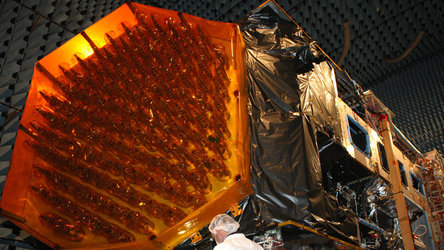Making the Galileo connection
On a humid afternoon in French Guiana, a small team of Spanish engineers watched as the second pair of Galileo satellites was launched, and the outcome of many years of effort ascended to the heavens.
With a quartet of Galileo satellites in space and the second two undergoing in-orbit testing, Europe’s own satnav programme is nearing the time when the first navigation fixes can be tried out.
It has taken the combined knowledge, capabilities and skill of companies both large and small from across our continent to reach this point.
This team, from Spain’s Mier Comunicaciones company, had contributed two key items to the twin satellites, launched on 12 October 2012: a new search and rescue transponder to pick up emergency distress calls from the ground or sea, and the Mission Receiver vital to maintaining Galileo’s positioning accuracy by picking up terrestrial correction messages.

“It was quite a striking moment to see the launch,” recalls Pedro Mier, CEO of Mier Comunicaciones.
“We have been involved with Galileo since the very first pilot studies, but for these first four satellites in the constellation we held direct responsibility for key pieces of equipment.
“To begin with, this second pair of satellites was the first to carry search and rescue transponders as part of the international Cospas–Sarsat system, picking up signals from emergency beacons on boats or aircraft in distress and relaying them to regional emergency centres.”

Cospas-Sarsat has been active for more than three decades, but Galileo’s transponders are a new departure for the system, operating in medium orbits for the first time, as opposed to low or geostationary orbits.
They also have the first return link for Cospas–Sarsat, able to reply to stricken vessels that their SOS has been received and help is on the way.
“We both designed and produced the transponder. Significantly for our company, this was the first time we delivered a complete satellite transponder,” adds Mr Mier.

“The design had to include very sharp signal filters and efficient amplifiers within the transponder to pick up faint VHF signals within a wide satellite footprint, and all within a compact size and mass.
“It also had to be compatible with both Galileo satellite designs – the initial as well as follow-on Full Operational Capability satellites.
“But the single greatest challenge was undoubtedly the extremely challenging schedule: in order to fly we had to design, qualify and produce the transponder in less than 14 months. It was very demanding but we did it!”

There was more time available for Mier Comunicaciones’ other main contribution. The Mission Receiver receives the uplinked navigation and correction data generated by the Galileo system’s worldwide ground segment.
Galileo’s ground segment works like a planetary-scale closed-loop correction system, assessing the performance of the individual satellites and their nanosecond-scale accuracy atomic clocks to keep Galileo accurate. By receiving the resulting corrections, the Mission Receiver closes this loop.
“Operating in C-band microwave, this is a key item,” comments Mr Mier. “It combines very sensitive radio-frequency performance with a significant amount of digital processing, because the Mission Receiver has to interact with the satellite’s Navigation Signal Generator Unit in order to produce the corrected signal for transmission to users.”
The success of the company’s design speaks for itself: it has been sold for use on all 26 of the Galileo satellites purchased to date, the initial satellites produced by Astrium and the next 22 manufactured by OHB and SSTL.
“And as a consequence of our Galileo experience, we have been awarded a new contract for ESA’s Meteosat Third Generation satellites,” adds Mr Mier.

“This is the Data Collection System and Search and Rescue, marking the first time we are contributing a complete subsystem to a prime contractor.”
A second-generation family-run small-medium enterprise, Mier Comunicaciones won its first contract with ESA back in 1985, applying new Ku-band satellite dish technologies developed in cooperation with the Politechnic University of Barcelona, where Mr Mier also teaches part-time.
“We have worked extensively with ESA, being active across almost all Agency programmes,” concludes Mr Mier.

“Our contribution to ESA programmes has in turn opened up commercial opportunities, such as contracts for the new generation of US mobile telecommunications satellites, including Loral Space Systems’ ICO/DBSD and Terrestar satellites.
“We were also contracted by Astrium to supply all the 250 low-noise amplifiers on Inmarsat’s new Alphasat telecommunication satellite – the first time the company has used a European as opposed to Japanese supplier.
“So, as a smaller company, our experience with ESA has been a good one, with the resulting innovations translating into new contracts, contributing directly in turn to European exports, jobs and growth.”















 Germany
Germany
 Austria
Austria
 Belgium
Belgium
 Denmark
Denmark
 Spain
Spain
 Estonia
Estonia
 Finland
Finland
 France
France
 Greece
Greece
 Hungary
Hungary
 Ireland
Ireland
 Italy
Italy
 Luxembourg
Luxembourg
 Norway
Norway
 The Netherlands
The Netherlands
 Poland
Poland
 Portugal
Portugal
 Czechia
Czechia
 Romania
Romania
 United Kingdom
United Kingdom
 Slovenia
Slovenia
 Sweden
Sweden
 Switzerland
Switzerland


































